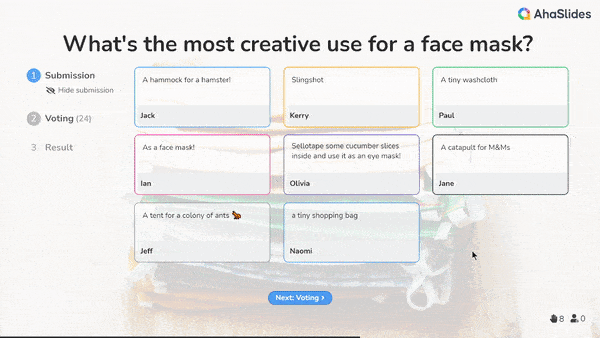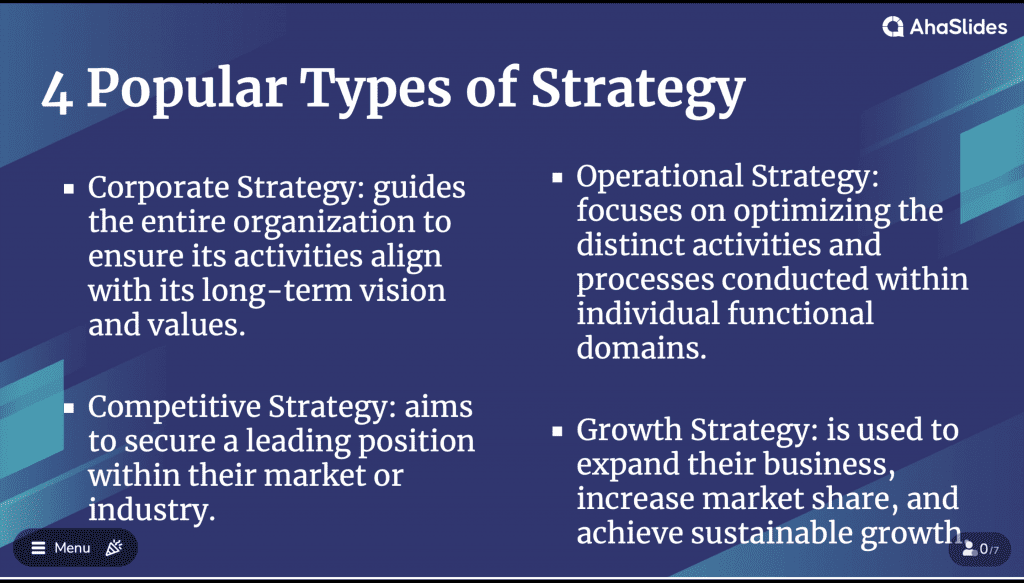“最大的風險是不冒任何風險。 在一個瞬息萬變的世界中,唯一注定會失敗的策略就是不冒險。”馬克·扎克伯格說道。
戰略是企業在激烈的市場競爭中立於不敗之地的核心。 為下一步行動選擇的每一個策略都像是在冒險。 風險等於機遇,明確的戰略在將風險轉化為機遇方面發揮著重要作用。
那什麼是最好的 策略類型 企業該關注哪些因素?讓我們深入研究這篇文章,了解更多!
目錄
什麼是戰略?
戰略是旨在實現特定目標的深思熟慮的計劃或方法。 它包括設定明確的目標、分析情況、做出決策、規劃行動以及在必要時進行調整。
從業務到個人發展的戰略在各種情況下被用來指導決策和有效的資源分配,以實現預期的結果。
AhaSlides 的更多提示

主持一個 現場頭腦風暴會議 免費!
AhaSlides 讓任何人都可以從任何地方貢獻想法。您的觀眾可以透過手機回答您的問題,然後投票選出他們最喜歡的想法!請依照以下步驟有效促進腦力激盪會議。
為什麼公司應該考慮不同類型的戰略?
了解策略類型與應用正確的策略同樣重要。 組織應該充分了解每種類型的戰略有以下幾個原因:
- 不同的情況需要不同的方法,了解每種策略類型的細微差別可確保所選策略與組織的總體願景和使命保持一致。
- 市場環境瞬息萬變。如果一種策略行不通,公司可以轉向另一種更適合當前情勢的策略。
- 不同的策略需要不同的資源分配。
- 每種策略類型都有其自身的風險和潛在回報。
戰略管理中常見的戰略類型有哪些?
以下是一些可應用於戰略管理的常見策略類型。 顯然,當今幾乎所有組織都經常結合和調整這些策略,以適應其特定目標和市場條件。
“一家公司只有能夠建立並保持差異性,才能超越競爭對手。”
by 邁克爾·波特, 哈佛商業評論

企業戰略
企業策略是當今企業最常使用的策略類型之一。它是一種高層藍圖,定義了組織的整體方向和目標。它涵蓋了市場佈局、資源配置、策略定位、合作機會、風險降低、永續性和成長目標等方面的決策。此策略指導整個組織,確保其活動符合其長期願景和價值觀,從而實現最終目標。
競爭策略
組織採用精心設計的計劃來確保其在市場或行業中的領先地位。 它需要精確定位目標市場,為客戶提供獨特的價值,確定競爭優勢(例如成本領先或差異化),並進行有效的資源配置。 競爭戰略對於通過為客戶提供卓越價值來實現持續成功和超越競爭對手至關重要。
邁克爾·波特指定了四種類型的競爭策略,這些策略可以應用於任何商業組織,無論產品的規模和性質如何。 其中,差異化戰略是最有效的戰略之一。 市場上有數以千計的銷售人員在銷售類似的產品和服務。 當蛋糕被所有強大的競爭對手吃掉時,你的企業如何才能獲得更大的份額? 答案在於執行良好的差異化戰略。 它通常伴隨著溢價定價,當客戶意識到產品或服務的附加值,從而導致利潤增加時,他們願意支付溢價。
經營策略
對於小型和大型組織來說,諸如運營戰略之類的戰略類型都是必須考慮的方法。 組織內的一個規劃層,專注於優化各個職能領域(例如營銷、財務或生產)內進行的不同活動和流程。 其主要目標是保證這些職能與組織的總體業務目標相協調並支持該目標。 運營戰略需要完善流程、明智地分配資源、建立績效基準以及監督日常運營的各個方面,以提高效率、質量和競爭實力。
增長戰略
增長戰略是最重要的戰略類型之一,描述了組織用來擴展業務、增加市場份額和實現可持續增長的深思熟慮的計劃。 它涉及進入新市場、開發新產品或服務、進一步滲透現有市場、進入不相關領域、建立合作夥伴關係和利用創新等活動。 有效執行增長戰略需要仔細規劃、資源分配以及適應不斷變化的市場動態。
當今商業中的策略例子有哪些?
蘋果公司就是在市場波動和經濟下行的情況下在正確的時間採取正確策略的著名例子。
- 蘋果的差異化策略:蘋果的競爭策略以產品差異化為核心。該公司持續推出創新且外觀精美的產品,例如 iPhone、iPad 和 Mac,這些產品都擁有高昂的價格。蘋果的品牌忠誠度和生態系統整合進一步強化了其差異化策略。

由於 2015 年Google Alphabet 的及時轉型,Google已成為使用最廣泛的網路搜尋引擎。
- Google Alphabet 重組(2015 年):Google母公司 Alphabet Inc. 進行了重大的企業策略轉型,將旗下各項業務重組為 Alphabet 旗下的獨立子公司。此次重組使Google能夠專注於其核心搜尋和廣告業務,同時使 Alphabet 的其他子公司能夠開展創新業務。
特斯拉還擁有出色的商業戰略,許多公司都將其視為寶貴的經驗教訓。 他們不關注眼前的利益,而是著眼於長遠,目標是成為世界上最大的汽車公司。
- 特斯拉 供應鏈戰略:這是他們最明智的投資之一。他們透過押注電池製造商,完全掌控了供應鏈,從而更靈活地應對需求變化。截至2023年5,265月,特斯拉營運著一個由48,000個超級充電站和超過XNUMX個充電介面組成的網路。這是特斯拉的關鍵競爭優勢,並有望在未來幾年幫助公司繼續成長。
如何為組織選擇正確的戰略類型?
在這一部分中,我們提出了五個技巧,可以幫助組織在選擇策略時奠定堅實的基礎,以便做出明智的戰略決策。

- 了解組織目標:
這是至關重要的,因為將所選策略與組織的整體使命和願景相結合可確保該策略支持組織的核心宗旨。
- 行業及競爭分析:
對產業和競爭格局進行透徹分析至關重要,因為它為明智的決策奠定了基礎,並幫助組織了解其競爭地位。討論使用 SWOT、PESTEL 和波特五力模型等工具進行透徹分析的必要性,以了解市場狀況、威脅和機會。
- 評估內部能力:
了解組織的內部優勢和劣勢至關重要。如果沒有這種評估,就很難確定組織是否擁有有效執行所選策略所需的資源和能力。這包括評估財務資源、人力資本、技術能力和營運效率。
- 資源分配:
確保資源可用性符合所選策略的要求至關重要。 如果沒有適當的資源分配,即使是最好的策略也可能會失敗。
- 監測和評估
建立績效指標和關鍵績效指標 (KPI) 來追蹤進度並進行調整,對於持續取得成功至關重要。如果沒有有效的監控和評估,組織就無法確保策略按計畫推進並取得預期成果。
關鍵要點
值得注意的是,每種策略的有效性都受到各種因素的影響。 適合該公司的策略可能不適用於您的公司。 在不斷發展的商業環境中,緊跟最新趨勢並樂於探索不同的方法對於長期成功至關重要。
🌟想要更多靈感嗎? 查看 啊哈幻燈片 將您的演示和觀眾參與度提升到一個新的水平。
常見問題(FAQ)
戰略分析下的4種戰略是什麼?
在戰略分析方面,有四個層次的戰略:(1)公司層面的戰略,(2)業務層面的戰略,(3)職能層面的戰略,(4)運營層面的戰略。
11種策略是什麼?
現代商業中常用的戰略有11 種,包括結構主義戰略、差異化戰略、撇脂戰略、收購戰略、聚焦戰略、交叉銷售戰略、可持續性戰略、多元化戰略、保留戰略、投資組合限制戰略和增長戰略。
四種競爭策略是什麼?
根據邁克爾·波特的說法,競爭戰略是一種廣泛的方法,可以分為四個較小的類別:
成本優勢 戰略側重於以低於競爭對手的成本生產產品或服務。
區別 戰略涉及創造獨特的產品或服務,並提供客戶看重的東西。
專注於 該策略針對特定的細分市場,並比競爭對手更能滿足該細分市場的需求。
綜合成本領先/差異化 戰略是成本領先和差異化的結合。








